-
Come talk to us on April 19.
Month: March 2011
The University’s dark past
-
Should be required reading for every UVA student and alum.
“it’s not his fault that he wants to dance/on top of a/piano”
-
Don’t read this if you are easily offended, but o my goodness the parody of both Bukowski and Peanuts is just about pitch perfect, particularly in the poems.
New on the Wiki: The Slutzky Collection
I gave Jeff Slutzky, who was in the Virginia Glee Club with me starting in 1992 and continued on and off in the group throughout the 1990s, a lift back from the 140th reunion weekend last week. He had offered to lend me a set of Glee Club programs from his time in the group to scan for the archives. We listened to Glee Club recordings across about six decades and chatted for a long time. When we got into New York, he asked if I wanted to come in for a minute to go through his collection of programs.
And thus it was that I had delivered into my hands a nearly complete set of Glee Club programs from the entire 1990s–filling in all the blanks in my personal archives from the early 1990s, and carrying on through the late 1990s and the beginnings of the Bruce Tammen years. And I thought I was a packrat, until I saw Jeff’s collection, which included not only programs from tour performances but even set lists from Lawn Concerts. Well done, Jeff. I’ve been scanning the archive all week and have plenty more to go; you can watch the progress here.
Coincidentally, Jeff’s materials arrived at the same time as two other bodies of material: a set of scanned posters from the Glee Club’s capable arts administrator covering the same period, and a set of programs, tour photos, and even recordings from the late 1970s courtesy of Dr. Anthony Gal. The posters are on the wiki already, the materials from Tony Gal will follow. The great thing about this is that just as we run out of the archives that were readily available to the Glee Club, its alumni are stepping up to provide more materials. So now I’m going to start tagging materials by donor as I post them, as a way of thanking contributors to the project.
Virginia Glee Club 140th Anniversary Weekend
The Virginia Glee Club 140th Anniversary Weekend was last weekend, and was so wonderful that I fell behind in my work and am still catching up. But what a way to fall behind.
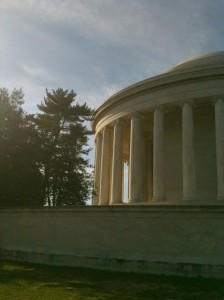 I drove down from Massachusetts to DC on Thursday, where I spent time at the Jefferson Memorial before catching up with my first year roommate Greg Greene. The next morning, I hopped back in the car and drove down, spending the morning and early afternoon in the Small Special Collections Library doing research before going on to the first cocktail party of the weekend.
I drove down from Massachusetts to DC on Thursday, where I spent time at the Jefferson Memorial before catching up with my first year roommate Greg Greene. The next morning, I hopped back in the car and drove down, spending the morning and early afternoon in the Small Special Collections Library doing research before going on to the first cocktail party of the weekend.
After spending months and months building up the Virginia Glee Club history wiki, it was nothing short of astonishing to meet so many alums–and to be able to talk intelligently with them about what they did during their time in Club. We had a splendid meeting of alums in the Colonnade Club before moving on to the Glee Club concert, in which Club acquitted themselves nobly.
The concert also raised awareness of just how powerful this collection of singing alums and students could be. When Frank Albinder called alums to stage to sing the alma maters of the University (“Virginia, Hail, All Hail” and “The Good Old Song“), the 130 voices pretty much blew the roof off Old Cabell Hall. Afterwards, we all fetched up on the Corner, where we learned that the Trinity Pub (née the Greenskeeper, née Jabberwock, née many others) was too loud for some of the 90s era old timers (though not, surprisingly, for the 70s era guys). We relocated to St. Maartens, home of many an inaugural drinking experience on 21st birthdays, where at least one Club alum still had a mug hanging at the bar, and closed the night at Littlejohns, home of much late night gastric distress.
The next morning was transcendental, as Club members reunited with old (and new-to-us) directors to review repertoire, then performed on stage. Don Loach’s alumni performance of “A Shadow’s on the Sundial” was probably the most emotional, as he confessed, “The ending of that song gets me every time!” The group then repaired to the Rotunda; on the way, a group of current Club guys gathered to sing “Coney Island Baby” and other works. By the time they were at the Rotunda, they had moved on to “Loch Lomond,” in which many an alum joined in. We then took our collective 130+ voices to the portico of the Rotunda to serenade the startled onlookers with “Virginia, Hail, All Hail” and “The Good Old Song.”
The evening banquet featured more activities, including announcement of a details-pending initiative to fund scholarships for students to engage in Club’s keynote activities of musicianship, leadership, and fellowship; speeches from several including former University president John Casteen, who pointed out that Club’s custodianship and performance of the University songs including “The Good Old Song” constitute one of its most important contributions to the University; and announcement of a digital remaster of the Shadow’s on the Sundial album (available to donors). The evening concluded with many visiting various Corner bars and washing up at The White Spot.
The Glee Club has come a long way since 1899, when Corks and Curls memorably published a fake notice stating that it could “furnish funeral music on short notice.” The extended Fraternity of Talent embraces more than 2000 named alumni of the group to date, and I think that the 100+ that attended the reunion would agree that the more often all could come together, the better.
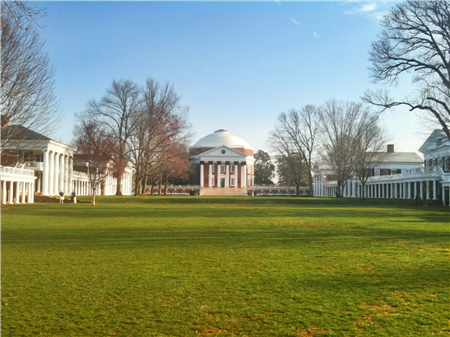
Style guide for the web
-
Comprehensive guidelines to create good web typography.
The Glee Club’s visual identity
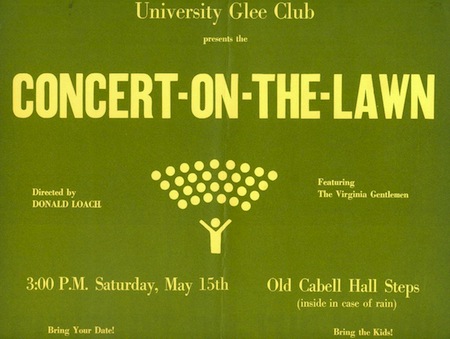
Over the weekend I did some curation of the Virginia Glee Club history wiki, pulling together some previously posted images into new categories and scanning a few large format posters. You can now see all the posters and program covers that we’ve scanned in one place.
Looking at all of them in order, I’m reminded of my own role in the evolution of the graphic look of the Glee Club as expressed through its posters, programs, and tape jacket covers. From about late 1991 through late 1993/early 1994, I was either the “typesetter” (aka Quark Xpress jockey) or designer of all the Glee Club’s printed matter, and it’s interesting now to remember that we really had a firm (if amateur) idea about the direction in which we were going, graphically speaking. And looking at it in the context of what came before, it’s interesting just how different that direction was from what the Glee Club’s visual identity had been before.
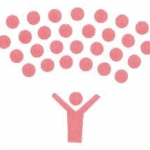 I think it’s fair to say that, based on the evidence that has survived, that there was really no distinctive graphic identity for the Glee Club prior to the mid-1960s. While it’s hard to say for sure–posters and other large printed ephemera are rarer in the historian’s archives than programs–all the printed matter I have before 1965 is simple, generally typeset, and consistent, probably in a University “house” style. This started to change once Donald Loach took over leadership of the group. As early as Christmas 1965, and maybe earlier, the glyph to the right started to appear on Glee Club printed matter. Designed in the International style, the icon was clear and recognizable, and put a new graphic element into the Club’s printed materials. The “Y conductor” icon appears often through the 1960s and 1970s, most strikingly as the central design element in the poster for the 1971 Concert on the Lawn. But it was not used consistently, and in fact by the mid-1970s had largely disappeared in favor of more visual graphic elements intended to reinforce the theme of each individual concert: woodcuts for concerts of medieval and Renaissance music, sheet music for a concert of Viennese works, silhouettes of Jefferson and images of the Lawn for University functions.
I think it’s fair to say that, based on the evidence that has survived, that there was really no distinctive graphic identity for the Glee Club prior to the mid-1960s. While it’s hard to say for sure–posters and other large printed ephemera are rarer in the historian’s archives than programs–all the printed matter I have before 1965 is simple, generally typeset, and consistent, probably in a University “house” style. This started to change once Donald Loach took over leadership of the group. As early as Christmas 1965, and maybe earlier, the glyph to the right started to appear on Glee Club printed matter. Designed in the International style, the icon was clear and recognizable, and put a new graphic element into the Club’s printed materials. The “Y conductor” icon appears often through the 1960s and 1970s, most strikingly as the central design element in the poster for the 1971 Concert on the Lawn. But it was not used consistently, and in fact by the mid-1970s had largely disappeared in favor of more visual graphic elements intended to reinforce the theme of each individual concert: woodcuts for concerts of medieval and Renaissance music, sheet music for a concert of Viennese works, silhouettes of Jefferson and images of the Lawn for University functions.
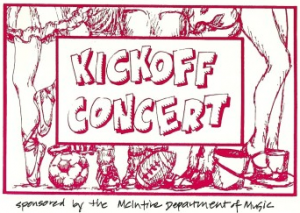 By the 1980s, a more hand drawn style had begun to emerge. The iconic Christmas wreath, as shown on the cover of the Christmas program from 1982, is colorful, hand drawn, and generally less formal than the 1970s programs. The Kickoff Concert cover from 1988 is even less formal, looking sketchy and even cartoony. Both of these designs would persist into the early 1990s, and both were around when I began as “computer dude” for the Club in the fall of 1991. While I didn’t save the posters or programs, I remember this design for the Kickoff Concert being in use in both 1990 and 1991, and certainly the Christmas wreath stayed throughout this period.
By the 1980s, a more hand drawn style had begun to emerge. The iconic Christmas wreath, as shown on the cover of the Christmas program from 1982, is colorful, hand drawn, and generally less formal than the 1970s programs. The Kickoff Concert cover from 1988 is even less formal, looking sketchy and even cartoony. Both of these designs would persist into the early 1990s, and both were around when I began as “computer dude” for the Club in the fall of 1991. While I didn’t save the posters or programs, I remember this design for the Kickoff Concert being in use in both 1990 and 1991, and certainly the Christmas wreath stayed throughout this period.
![]()
When John Liepold came on board as a fresh new conductor in 1991, he took a hands on approach with the design of programs, letterhead, and other printed matter. He probably was the designer of the distinctive Virginia Glee Club letterhead–Palatino bold, with the word “the” in small caps, a thick rule beneath, always either black on white or white on black–and its use and design was the one consistent rule graphically during those years, along with the use of Palatino as the standard font. The intention was to be more visually bold and to get our name out more, and–given the limited typographic palette available in 1991 even on a Macintosh–I think it was pretty successful.
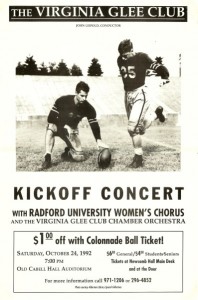 My contribution, other than general typographic contributions, was to add more photographic and representational imagery to the mix. Some of the posters I produced were simple retreads of designs that were already in use when I came on board (the Finals Concert poster is in this camp) but others were complete redesigns. The Kickoff Concert, which was my first poster the year I was vice president, was my first target, and I decided to go with an image from the archives that would be visually bold, memorable, and tied into the history of the University. That I happened to see this photo in the Special Collections archives a few months after seeing this poster for the first time was a happy graphical accident. We used it again in 1993 but I don’t think the poster reappeared since then. But the basic themes–striking imagery, ties to the history of the University to reinforce our claim as the oldest musical group on Grounds, fun–were to appear again in other posters. (I wrote about this poster once before a few years ago.)
My contribution, other than general typographic contributions, was to add more photographic and representational imagery to the mix. Some of the posters I produced were simple retreads of designs that were already in use when I came on board (the Finals Concert poster is in this camp) but others were complete redesigns. The Kickoff Concert, which was my first poster the year I was vice president, was my first target, and I decided to go with an image from the archives that would be visually bold, memorable, and tied into the history of the University. That I happened to see this photo in the Special Collections archives a few months after seeing this poster for the first time was a happy graphical accident. We used it again in 1993 but I don’t think the poster reappeared since then. But the basic themes–striking imagery, ties to the history of the University to reinforce our claim as the oldest musical group on Grounds, fun–were to appear again in other posters. (I wrote about this poster once before a few years ago.)
The other major redesign I presided over was the Christmas concert. Wanting to freshen the wreath, I asked Craig Fennell to help me design a replacement, and he obliged with the “quarter-wreath” treatment we used on the 1992 and 1993 Christmas concert materials. I think this design was less punchy than some of the other posters we did, but the overall effect was still good.
 The other contribution I made was the “letterpress homage poster”–posters that mimicked presentation forms and styles from the letterpress era. Inspired by an English playbill poster that had been recreated in the Colonial Williamsburg printing office with honest to goodness movable type, I designed three posters in this style: a poster for the joint U Singers/Glee Club Messiah Sing-In in the style of an 18th century English playbill, a Lawn Concert flier in the style of a 19th century advertisement, and the poster for the Spring Concert in 1994. Of the three, the Messiah one is probably my favorite as graphic art–clean, dramatic, colorful, and correct use of the long “s”–but the Lawn Concert flier was probably the most effective at getting bodies to the show. Something about the little Porte Crayon student seems to strike a chord with viewers even today.
The other contribution I made was the “letterpress homage poster”–posters that mimicked presentation forms and styles from the letterpress era. Inspired by an English playbill poster that had been recreated in the Colonial Williamsburg printing office with honest to goodness movable type, I designed three posters in this style: a poster for the joint U Singers/Glee Club Messiah Sing-In in the style of an 18th century English playbill, a Lawn Concert flier in the style of a 19th century advertisement, and the poster for the Spring Concert in 1994. Of the three, the Messiah one is probably my favorite as graphic art–clean, dramatic, colorful, and correct use of the long “s”–but the Lawn Concert flier was probably the most effective at getting bodies to the show. Something about the little Porte Crayon student seems to strike a chord with viewers even today.
I’m sadly short on examples of work after I left–hope to scan some this weekend–though I would be remiss if I didn’t point out that Craig Fennell, Matt Vanderzalm, and others kept the artistic streak of our poster work alive through at least the late part of the 1990s.
Seeking the UVA Madrigal Group
The UVA Magazine posted a great collection of stories from women at the University of Virginia. One area that they didn’t dive into was the history of women’s choral music at the University.
The earliest reference we have to women of the University community participating in Glee Club performances comes in 1944, when a “Madrigal Group” made up of women from the University joined the Glee Club in its fourth annual Christmas concert. The Madrigal Group lasted two seasons, disbanding after the end of World War II, and except for a brief reinstatement in the 1950s there is no further word about a women’s choir until the formation of the University of Virginia Women’s Chorus in 1974. So while the Glee Club collaborated in virtually every home concert with a women’s chorus, they always had to reach outside the University community for their collaborations.
It would be great if any of the original members of that Madrigal Group could share their stories. According to the December 15, 1944 “College Topics,” they included Kathryn Bell, Barbara Bishop, Phyllis Black, Joyce Blume, Adele Chauvenet, Mary Costello, Virginia Cummings, Nancye Jane Davis, Renee Gretcke, Barbara Harris, Mary Lamb, Jeanne Mills, Margaret Neale, Betty Pritchett, Roberta Richman, Catherine Spencer, Doris Spradlin, Mae Thacker, Virginia Ware, Anna Witt, Mary Broyles, Dudley Burruss, Priscilla Calmer, Calise Chauvenet, Mary L. Forbes, June Kittleson, Betty Newton, Nancy Spicer, Patsy Walker, and Mary Wheat.
Bright lights
-
A rewarding quick and easy do-it-yourself repair.
Scaling beyond Delicious
-
How to scale SaaS under duress. Also, an interesting alternative to Delicious, if someone can suggest a way to do autoposting from it.
Grab bag: Movies &c.
-
Free open source fonts that each contain only one character, &. A beautiful selection.
-
Smart article on the downward spiral of good movies.
Countdown to ending IE6
-
From Microsoft, a well designed site encouraging moving off IE6.
